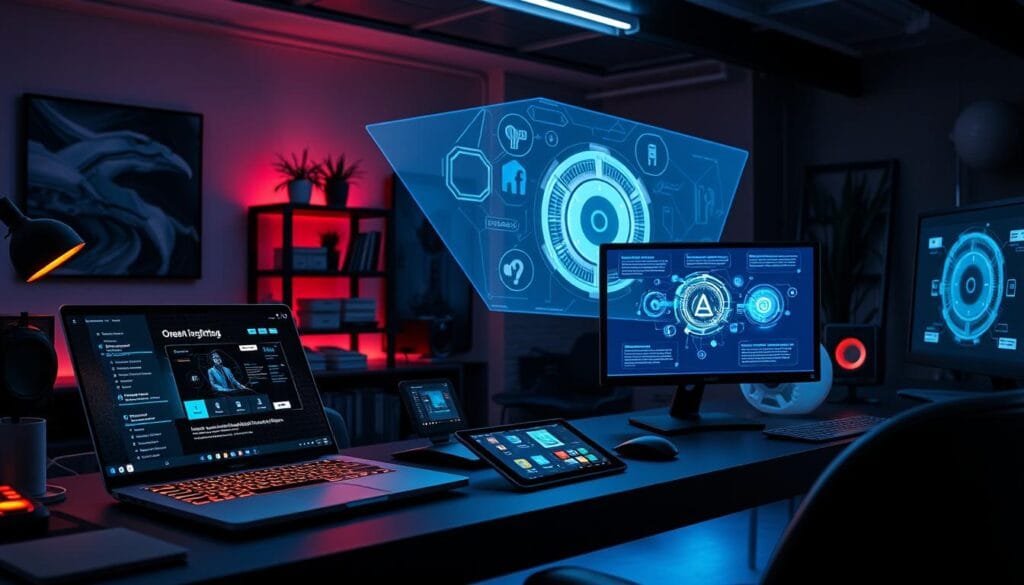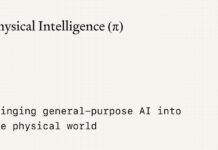Did you know over 60% of professionals use generative AI for creative tasks in 2023? This shows how generative AI is changing many fields. OpenAI, started in December 2015, is a key player in this change. It introduced ChatGPT in November 202212.
ChatGPT can make text, images, and even music. This shows how versatile generative AI is1. It uses GPT-3 and GPT-4 models, showing OpenAI’s big steps in AI2. Exploring OpenAI and generative AI reveals its huge impact on AI’s growth.
Key Takeaways
- OpenAI was established in December 2015 and has since revolutionized AI technology.
- ChatGPT, launched in November 2022, demonstrates the capabilities of generative AI.
- Generative AI can create a variety of content, including text and images.
- OpenAI’s models have applications ranging from language translation to content generation.
- Generative AI has become a vital tool in multiple industries, enhancing creativity and efficiency.
Understanding Generative AI
Generative AI is a big step in artificial intelligence. It can make new content from old data. It uses smart machine learning to find patterns in big datasets. This helps create things like text, images, and music.
Definition of Generative AI
Generative AI is a part of AI that creates content. It uses lots of data to make things that seem like they were made by humans. For example, ChatGPT uses big language models to talk to us.
ChatGPT’s new model, GPT-4, has about 100 trillion parameters. This makes it much better than the old ones3.
Applications of Generative AI
Generative AI is used in many areas, making things better and more creative. It can make lots of different content, like essays and images. For example, DALL·E can make real images from text, changing how we make pictures34.
Experts say generative AI could add up to $4.4 trillion to the world’s economy every year. This shows how important it is4. It helps IT, marketing, and healthcare work better and be more creative.
What is OpenAI?
OpenAI is a key player in artificial intelligence, with a rich history and founding. It was started in December 2015 by Elon Musk and Sam Altman. They wanted artificial general intelligence (AGI) to help all of humanity. OpenAI began with a $1 billion investment, showing its big goals and drive for innovation5.
History and Founding of OpenAI
In 2018, OpenAI changed from a nonprofit to a for-profit company. It became OpenAI LP under OpenAI Inc. This move allowed it to grow more, thanks to partnerships like the one with Microsoft. Microsoft invested $13 billion and now owns about 49% of OpenAI, helping it expand its influence6.
Research and Development Focus
OpenAI works hard to improve AI in many areas, like natural language processing and machine learning. It’s known for its big models, like GPT-3 and ChatGPT, which change how we use AI7. These models help many industries, like telecom and healthcare, showing OpenAI’s important role6.
OpenAI also focuses on making AI fair and responsible. It aims to use its tech in ways that are good for everyone, tackling both the benefits and risks of AI7.
Is OpenAI a Generative AI?
OpenAI is a key player in generative AI. It has developed many models and technologies. These models can create text and content that seems human-made, making them useful in many areas.
OpenAI’s Models and Technologies
OpenAI’s ChatGPT has become very popular, with almost 70% of the market share in AI tools. It answers questions well and clearly. In 2022, ChatGPT 3.5 gave good answers. Now, OpenAI has GPT-4 and a mini version, which can handle bigger texts better8.
OpenAI keeps improving its AI. This helps make content better and prepares for new ideas.
Comparison with Other Generative AI Systems
OpenAI’s models are compared to GANs and VAEs. They are good at making realistic texts and stories. Other AI systems also make new content, like code and music. But OpenAI’s API lets developers make their own apps, giving it an edge9.
OpenAI’s models are used in many fields. They help make things more personal and speed up new discoveries. This shows how AI is getting better and more useful.
OpenAI’s Notable Products

OpenAI has made big steps in artificial intelligence with many products. ChatGPT is a top conversational AI tool. It was released in November 2022 and quickly became very popular10. It uses advanced tech to talk and understand users in a smart way.
ChatGPT: The Conversational AI
ChatGPT is known for its smart text responses. It uses tech from earlier models to change how we talk and write. It helps people and businesses save time and money with daily tasks11.
Other Generative AI Models: Codex and DALL·E
OpenAI also has Codex and DALL·E. Codex helps with coding by turning words into code. DALL·E, introduced in 2021, makes amazing images from text. These products show how AI can do many things11.
The Impact of OpenAI on Industries
OpenAI has made a big splash in many fields with its new tech. It’s changed the game in content creation, healthcare AI, and education AI. Now, companies can do things faster and better, thanks to these smart tools.
Transforming Content Creation
OpenAI’s models have changed how we make content. Businesses can now write things automatically. This could add $2.6 trillion to $4.4 trillion a year to the economy, making AI even more powerful12.
About 75 percent of the benefits from AI come from tasks like marketing and software engineering12. Companies are seeing big improvements in how they work. They’re getting better at reaching out to customers and making things more efficient.
Applications in Healthcare and Education
In healthcare, OpenAI is making a big difference. The Mayo Clinic uses OpenAI’s GPT-3 model to help doctors make fewer mistakes and care for patients faster13.
Schools are also using OpenAI’s tech. Khan Academy uses it to make learning more personal and engaging. This has really helped students do better in their studies13.
Challenges and Considerations
The rise of generative AI has sparked big talks about its ethical implications. People worry about fake news, biased AI, and jobs lost. OpenAI works hard to make AI safe and talks openly about AI’s role in society. They stress the need for clear and safe use of AI.
Generative AI can sometimes make mistakes because of biased data or model limits. This is a big problem for companies14.
Ethical Implications of Generative AI
Companies need to make sure their data is clean for AI to work well. This is key for business growth and security. Sharing sensitive data with AI can lead to unexpected issues.
Also, more money is being spent on AI, with a big jump in 202314. As AI gets better, it’s important to be open about how it’s trained. This helps keep user data safe and follows the law.
The Future of OpenAI and Generative AI Technologies
The future of AI looks bright, with more advanced generative tech on the way. This could change many industries for the better. For example, OpenAI’s ChatGPT and DALL-E can help with writing and making images.
Artists and teachers will also benefit a lot. Generative AI can create unique art and learning materials15. OpenAI will keep working on making AI safe and fair, following rules like GDPR and HIPAA.
Conclusion
OpenAI is a top name in generative AI, changing many industries with its new models and products. Its ChatGPT is especially impressive, making content that fits the conversation perfectly. This changes how we talk to machines a lot16.
This tech keeps getting better, showing how it can understand us like we do each other. It shows we can do even more in the future16.
The future of AI looks bright, with new ideas coming up all the time. These could make things better, but we also need to talk about the risks. Especially in places like hospitals and schools17.
OpenAI’s work helps us see where AI is going. It shows we need to think about how it affects society17.
Generative AI makes things faster, like writing, by 25% with ChatGPT. It also makes us think about rules for using it17.
We should keep watching how this tech grows. We need to deal with the big questions and problems it brings16.
FAQ
What is generative AI?
How does OpenAI contribute to generative AI?
What are the main applications of OpenAI’s products?
What ethical considerations surround generative AI?
What innovations are associated with OpenAI?
How has OpenAI’s work influenced various industries?
What is the future outlook for OpenAI and generative AI technologies?
Source Links
- What is the difference between OpenAI and generative AI?
- What Exactly Are Generative AI, OpenAI, and ChatGPT?
- Generative AI, OpenAI, and ChatGPT: What are they?
- What is generative AI?
- What is OpenAI? Definition and History from TechTarget
- OpenAI
- Microsoft OpenAI & Generative AI services
- OpenAI: Everything You Need to Know About the Company That Started a Generative AI Revolution
- OpenAI vs. Generative AI Considerate the Key Differences Elucidated
- What is OpenAI? AI Features, Benefits & More
- What Is OpenAI? Everything You Need to Know
- The economic potential of generative AI: The next productivity frontier
- AI Powered Growth: Real-World Examples of Open AI’s Impact on Business Growth
- The challenges of implementing Generative AI in identity management
- Privacy Considerations for Generative AI – Privacy & Cybersecurity
- What is Generative AI, the technology behind OpenAI’s ChatGPT?
- Generative AI Is All About the Money (SSIR)







